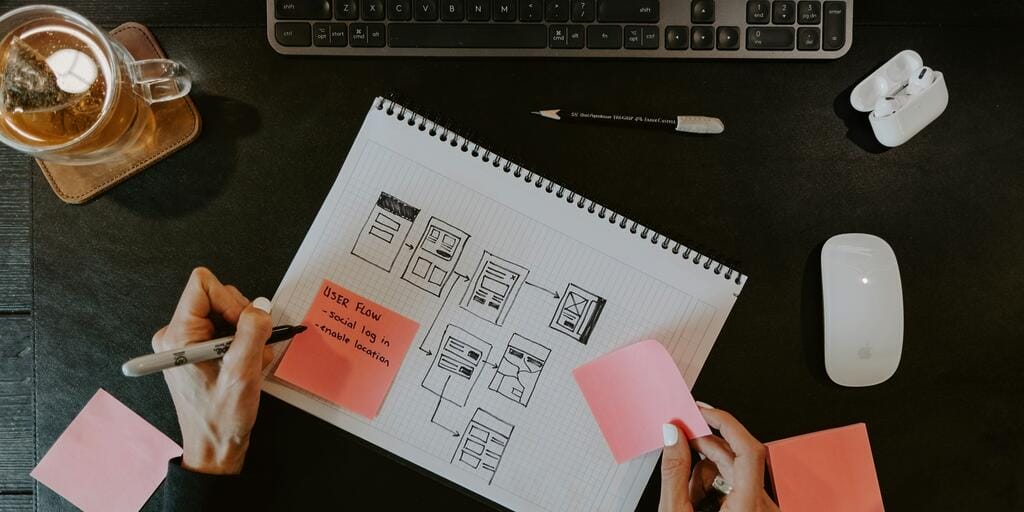
The Website Design Process
In the ever-evolving business landscape, establishing a robust online presence isn’t just a savvy choice—it’s a necessity. At the heart of this is a meticulously crafted website. But what is the website design process and where do you begin? If you’re a business owner navigating the intricacies of web design and feeling a bit confused about the best starting point, worry not—your search has brought you to the right place.
Join us on a friendly and accessible journey as we unravel the steps involved in curating a captivating online presence tailored specifically for your business. Whether you’re a service provider, charity, organisation or retailer. Consider this your go-to guide, created to demystify the world of web design and make the process an enjoyable and fulfilling experience.
So, let’s dive in, your up-levelled online presence is closer than you think.
Crafting a Digital Identity
Crafting a strong digital identity is essential for businesses today. A well-defined digital identity not only enhances brand recognition but also builds trust among consumers. In an era where online interactions heavily influence purchasing decisions, a compelling and consistent digital presence can set a business apart from its competitors. It allows companies to communicate their values, showcase their expertise, and engage with their target audience in a meaningful way. Additionally, a thoughtfully crafted digital identity enables businesses to adapt to the evolving technological landscape, fostering adaptability and resilience in an increasingly digital-centric market.
Creating a website is more than just putting together a few web pages. It’s a strategic process aimed at achieving specific goals and catering to the needs of both your business and your audience.
We’ve broken down the web design journey into a series of comprehensible steps, ensuring that you not only understand the process but also gain insights into how each phase contributes to the overall success of your digital venture.
The Website Design Process
As a full-service agency, we’ve guided many clients through this process successfully over the years. So you can trust that we know our stuff. Designing a website involves a systematic process to ensure that the final product meets the goals and requirements of both the client and the end-users. While variations exist based on the project’s scope and requirements, here is a standard process for designing a website. These steps may seem lengthy but as a web design agency with many years of experience in the digital space, the proper planning in the early stages of the website design process leads to the best outcomes for all.
1. Define Goals and Objectives
Every successful venture begins with a clear vision. We kick off the web design journey by defining the goals and objectives of your website. What do you aim to achieve? Who is your target audience, and what features will make your website stand out? This initial step sets the tone for a purpose-driven web design process. Define measurable objectives to guide you and ensure your website aligns with your business goals.
Whether you’re a new business or an established organisation. It’s powerful to start from the beginning and get clear on your objectives. Researching your requirements ensures your web designer understands your vision and can support you in bringing this to life. At Primal Space we always get you to complete a requirements form, this is a questionnaire that acts as a starting point in understanding your vision. As well as ensuring that our agency is the right fit for your project.
2. Conduct In-Depth Research
Knowledge is the bedrock of informed decisions. Dive into the intricacies of your industry, study competitors, and understand your audience’s preferences. Our journey begins with thorough research, enabling you to make strategic design choices that resonate with your target demographic. Identify trends, user preferences, and best practices to inform your website design strategy.
A well-researched approach sets the foundation for a successful website. If you’re a new business or going through a rebrand, you may want to check out our guide on creating a brand identity. This will support you in the early planning stages and developing your website’s visual identity, an important part of the web design process.
3. Crafting a Website Blueprint: The Sitemap
Imagine your website as a carefully planned city. Develop a sitemap as the blueprint, outlining the structure and hierarchy of your site’s pages. This planning ensures more than just a pleasing aesthetic; it forms the backbone of a seamless navigation experience. Visitors are guided through a purposeful journey, effortlessly navigating your site to arrive at the desired outcomes. For e-commerce websites, this could be completing a transaction. While for service providers, this could be submitting an enquiry or booking an appointment.
This strategic approach in the process of designing a website not only enhances user satisfaction. But also contributes significantly to achieving the specific goals and objectives of your online presence. While guiding visitors through a purposeful journey.
4. User Persona and Journey Mapping
An important part of the website design process is understanding your audience better. This can be done by creating user personas or avatars that represent the people who will visit your website. Think about more than just basic details like age and location—imagine their likes, dislikes, and what makes them tick.
Next, draw out the paths these imaginary visitors might take on your website. This way, you’re not just guessing how people might use your site; you’re understanding it from their point of view. This friendly and understanding approach ensures that your website is meeting the expectations and needs of the people you want to reach. Developing an ideal customer profile ensures your website aligns with your target audience.
5. Wireframing
Imagine wireframes as the architectural blueprints of your website. In this phase of the website design process, the focus shifts to outlining the basic structure and layout of each page without delving into design specifics. Think of it as the skeleton that defines the spatial arrangement, ensuring optimal user experience and navigation before the creative elements come into play. Wireframing Outlines each page’s basic layout and structure, focusing on content placement and navigation without delving into intricate design elements. We’ve researched the best wireframe tools to help you get started.
6. Mockups and Design Concepts
With the wireframes as our guide, it’s time to breathe life into your website’s design. Digital mock-ups introduce colour, typography, imagery, and branding elements, providing a high-fidelity representation of how your website will look and feel. This stage of the web design process is where creativity takes centre stage, bringing your brand identity to life in a visually appealing manner. Design concepts help you visualise the final look and feel of your website.
7. Prototyping
The next part of the website design process is prototyping. So before diving into full website development, we build interactive prototypes to demonstrate the user experience. Prototypes are invaluable for user testing and validation, ensuring your website meets user expectations. The development phase involves collaboration between front-end and back-end developers, ensuring the functional and responsive execution of the approved design.
As an agency we create these mockups on a development site, allowing you to visualise the site in a live test environment before it’s made accessible to a wider audience. Our developers and design team collaborate to translate the envisioned design into a functional website. It’s not just about aesthetics; it’s about ensuring that the design seamlessly integrates with the technical aspects, creating a cohesive and user-friendly outcome.
8. Gather Feedback
Gathering feedback is another powerful part of the website design process. Share the basic outlines, colourful designs, and interactive models of your website with the people involved in your project, like teammates or important decision-makers. Ask them for their thoughts and opinions. It’s like showing them the blueprints, a preview, and a working model of what the website will be.
Then, listen to what they say and make changes to the designs based on their suggestions. This back-and-forth process helps make sure that what you’re creating matches up with the goals you have for your project. Gathering feedback from people of various ages and demographics can help iron out design issues that may have been overlooked before the development stage.
9. Development
Once everyone agrees on how the website should look, it’s time for the next step in the web design process! Imagine it like building a house after you’ve finalised the design. In this phase, different types of builders called front-end and back-end developers, work together like a team. They use the approved design as a guide to create the actual website.
The front-end developers make sure the parts you see on the screen look just right, while the back-end developers handle the behind-the-scenes stuff, making sure everything works smoothly. It’s a team effort to turn the pictures and plans into a real, working website that does what it’s supposed to do, ensuring functionality and responsiveness.
10. Testing
Before your website makes its grand debut, rigorous testing is imperative. This key step in the website design process involves meticulous examination across various browsers and devices to identify and rectify any glitches or inconsistencies.
Testing ensures that your responsive website design functions seamlessly, providing a positive user experience regardless of the user’s device or platform. We’ll thoroughly test your website to identify and fix any bugs or issues and guarantee a consistent user experience.
11. Content Creation and Integration
Now that you’ve settled on the appearance of your website, it’s time to bring it to life with content. This is always an exciting and enjoyable part of the website design process allowing you to get creative. Populate your website with essential elements such as text, images, videos, and more – everything you want your visitors to engage with. Ensure that each piece aligns seamlessly with the overall design and messaging strategy you’ve outlined.
Similar to ensuring the interior of your space is as captivating and harmonious as its exterior. This phase is where your website transforms from a visual concept into a vibrant platform, narrating your story and highlighting the unique aspects of your business. If you’re struggling to write engaging copy that reflects your brand identity, we can offer content writing as part of your web design project.
As well as the written content, quality images are an important key to an engaging website. A professional branding photoshoot is worth the investment, or if this isn’t possible most new phones have cameras that can take bright, high-resolution images. If neither of these is an option, you can find free stock images online.
12. SEO Optimisation
A part of the website design process that we never overlook is optimising your website for search engines by implementing SEO best practices. This includes optimising meta tags, using relevant keywords, and ensuring a crawlable site structure.
SEO optimisation allows your website to rank higher when people are looking for things related to your business. By doing this, you’re making it easier for search engines, like Google, to recognise and recommend your site when someone is looking for what you offer. Ensuring that potential customers find your website more easily online.
13. Pre-Launch Snagging
Pre-launch snagging is a crucial step when developing a website. Think of it as a final quality check before your website goes live. This process involves identifying and addressing any issues or “snags” that might hinder the website’s performance or user experience. By thoroughly examining the website pre-launch, you ensure that it not only looks great but functions smoothly.
This proactive approach helps in preventing potential problems that could turn away visitors or impact your online presence. Investing time in pre-launch snagging in partnership with your digital agency ensures a polished, error-free website. Providing a positive first impression to your audience and enhancing the overall success of your online business. This attention to detail sets the stage for a flawless launch process.
14. Website Hosting: Finding a Digital Home
Another important aspect of the website design process that business owners overlook is website hosting. Your website needs a reliable home on the internet. Website hosting involves selecting a server that can handle the traffic and demands of your site. Choosing the right hosting provider is crucial for ensuring optimal performance, security, and accessibility for your audience.
Finding a multi-service digital agency like ourselves can be beneficial as it minimises the friction of having to deal with multiple parties and ensures your hosting service is managed ongoing. We offer specific Magento Hosting for e-commerce businesses, which includes higher specifications than our WordPress hosting for smaller-scale websites. If you’re new to hosting and would like to learn more check out our post on the benefits of managed hosting v’s self-hosting.
15. Launch
You’ve worked through the website design process in partnership with your digital agency and the big moment is here—your website is all set to step into the digital spotlight. The launch is a well-coordinated team effort, bringing together developers, designers, and key stakeholders. It involves making your website accessible to the public after the development phase. The launch process begins with thorough testing to ensure all functionalities work seamlessly and that the user experience aligns with your business goals. Your digital agency will coordinate the transition from a development environment to the live server, ensuring a smooth and error-free transition.
Once launched, your website is ready for visitors. It marks a joyous celebration as your brand officially makes its debut in the online arena, ready to make an impact in the digital world.
16. Post-Launch Support
Even after the launch, the website design process and your digital journey aren’t over. Post-launch snagging involves monitoring your website for any unforeseen issues or user feedback. It’s a proactive approach to promptly address and resolve emerging issues, ensuring a continued positive user experience.
Post-launch support from your digital agency ensures that your website continues to perform at its best. By addressing any issues, making updates, and providing necessary maintenance. This support is like having a dedicated team to rely on, ensuring your online presence stays vibrant and effective over time.
17. Analytics and Monitoring
Implementing analytics tools to monitor website performance is the next stage of the website design process. Track user behaviour, analyse traffic, and gather insights to inform future improvements. With tools like Google Analytics, you can track how visitors behave on your website, similar to understanding customer preferences in a physical store. Dive into the data to see where your visitors are coming from, which pages they find most interesting, and how long they stick around. By gathering these insights, you gain a deeper understanding of what works well and what might need a little extra attention.
Just like studying sales reports helps you make informed decisions for your physical business, analysing website analytics allows you to make data-driven improvements to your online presence. It’s a continual process of learning from user behaviour and using those lessons to enhance your website, ensuring it stays not just functional but also optimised for the best possible user experience.
18. Continuous Improvement
The final stage of the website design process is to regularly review and analyse your website’s performance and user feedback. Implementing updates and improvements to enhance the user experience and meet changing requirements. This ongoing process isn’t just about keeping things running smoothly; it’s about making your website even better.
By staying in tune with user feedback and making necessary improvements, you’re not only enhancing the experience for your visitors but also staying adaptable to the ever-changing demands of the online world. It’s a bit like refining your business strategy based on what your customers need and ensuring that your digital storefront remains inviting and up-to-date.
Additional Steps in The Web Design Process We Support Our Clients With
What we’ve outlined so far is the traditional website design process, however, our agency offers some additional steps to support our clients with the ongoing support, maintenance and marketing of their websites.
19. Ongoing Website Support
A successful website isn’t a set-it-and-forget-it endeavour. Ongoing support is crucial for addressing any technical issues, updating content, and ensuring that your website remains responsive to the evolving needs of your business and users.
It’s the continuous assistance provided by your digital agency to keep your website running smoothly and adapting to changing needs. For business owners, this means having a reliable partner for the long haul, ensuring that your online presence remains optimal. This support involves regular maintenance, updates, and addressing any emerging issues to keep your website secure and performing well.
A reliable web support system ensures the longevity and effectiveness of your online presence. With ongoing support, your website stays current, efficient, and aligned with your evolving goals, providing a solid foundation for sustained success.
20. Website Maintenance
Why do I need website maintenance you may be asking? Regular maintenance is the key to keeping your website in top-notch condition. This involves updating software, fixing bugs, and implementing security measures. By investing in a consistent website maintenance package, you safeguard your website against potential issues and keep it running smoothly for the long haul.
A later part of the website design process, maintenance involves regular check-ups, updates, and fixes to keep your website running smoothly. Regular website speed audits every three months are essential to identify and address performance bottlenecks, ensuring optimal user experience, higher search engine rankings, and preventing potential business losses due to slow-loading pages. For business owners, this means peace of mind, as the agency takes care of technical aspects, security patches, and any unforeseen issues that may arise. This continuous support not only safeguards your website from potential glitches but also ensures it stays current and aligned with the latest industry standards. With ongoing maintenance, your online presence becomes a reliable and resilient asset, allowing you to focus on your business while the digital agency handles the essential upkeep to keep your website performing at its best.
21. Digital Marketing: Amplifying Your Reach
In the vast digital landscape, visibility is paramount. Digital marketing strategies are employed to amplify your online presence, reaching a broader audience through channels such as social media, search engine optimisation (SEO), and other online advertising avenues like PPC Marketing. This ongoing effort ensures that your website continues to attract and engage your target audience, once the website design process is completed. Digital marketing is the roadmap to continued success and evolution.
Each of these steps within this post contributes to the holistic journey of web design, transforming an initial concept into a dynamic and effective online presence. Understanding and embracing each phase of the website design process allows you to navigate the journey with confidence. Ensuring that your website not only meets but exceeds your business objectives. While sustaining your business growth not only now but into the future.
Designing Your Website
While the standard web design process often aligns with the “waterfall” model, it’s crucial to recognise the dynamic nature of the digital landscape. Agile development, a methodology gaining increasing prominence, introduces a more iterative and adaptable approach.
In the context of agile development, projects unfold in smaller, incremental phases, allowing for continuous feedback loops and adjustments. This agile methodology promotes collaboration, transparency, and responsiveness to changing requirements. Embracing agility in web design acknowledges that the journey isn’t a linear path but a series of interconnected cycles, ensuring the final product remains attuned to evolving needs.
As you embark on your web design journey, understanding these methodologies provides you with the tools to choose an approach that best suits your project. Whether you opt for the structured progression of the waterfall model or the dynamic responsiveness of agile development, the goal remains the same: a website that not only meets but exceeds your business objectives.
Your Websites Evolution
Remember, your website is not a static entity but a dynamic tool that evolves alongside your business. The steps outlined in this guide serve as a roadmap, guiding you through the intricacies of design and development. Regularly revisiting and reassessing your website’s performance and user feedback is integral to ensuring its continued effectiveness.
By following these steps, you’re not merely creating a static online presence; you’re cultivating a living, breathing extension of your business in the digital sphere. This adaptability positions your website as a responsive asset, capable of embracing new trends, technologies, and user expectations as they emerge.
So, as you embark on your website design journey, armed with knowledge and a strategic approach. Remember that the digital landscape is ever-changing, and your website should be too. Working alongside an experienced digital agency that sees your vision and can contribute to your evolution is a worthwhile investment and an essential partnership.
Primal Space is a multi-service digital agency specialising in Magento e-commerce website design & WordPress web development. While supporting clients with related services including website maintenance, web hosting and SEO. Find a full list of our digital services to support your long-term success.
Our team are ready to bring your project to life. Share your requirements with us to get started.
Happy designing, and may your website continue to evolve and thrive along with your business growth.






